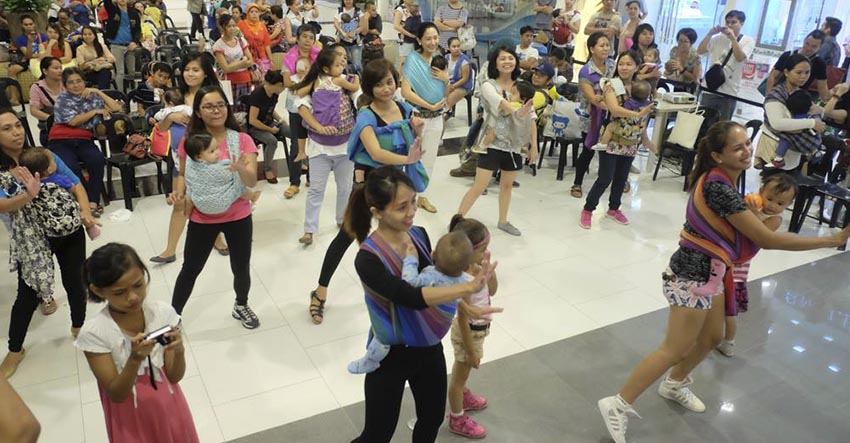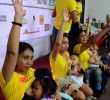
MOMBA. The International Babywearing Week was capped last Saturday with a zumba for mothers who are babywearing. The event was held on October 4-10 at the Abreeza Mall in Davao. (Contributed photo by the Babywearing Philippines Davao)
DAVAO CITY – What kind of parent wouldn’t want to bond with their babies and do household chores, exercise or take home office works at the same time?
Krissy Bagalihog is a mom to a 1 year old girl and finds the need to balance her household chores and attending to her daughters needs.
“When I get up from bed, I clean the room, prepare breakfast, do the laundry and tend to our store, that’s our daily routine. But my baby also wants me to be with her all the time,” she said, adding that it’s the reason why she chose to babywear.
Rosemarie Lindo said babywearing has helped her a lot in taking care of her 1 year-old son specially if there’s only the two of them.
“Babywearing helps a lot specially when I need to go out and I need to bring my son who is really heavy at his age,” she said.
She said bringing a stroller is inconvenient because it is bulky.
Krissy and Rosemarie are among the participants of the culmination event last October 10 where mothers and their babies celebrated the International Babywearing Week held at the Abreeza Mall Davao.
The gathering aimed to raise awareness on the benefits of babywearing. It was also touted as the “grand meet up” of Babywearing Philippines Davao (BWP Davao) who hosted the week-long event from October 4-10. This year’s theme is “Embrace your World”.
Karen Padawag, a member of BWP said the event is “a great time for a get together to celebrate the joy of keeping our babies close and spreading the love to others.”
“Babywearing is not just about carrying a child in a carrier. It’s more than that. It promotes bonding and builds confidence of new parents,” Padawag added.
BWP recognizes babywearing as an age-old practice by indigenous peoples, but said that it is just recently that babywearing is gaining popularity in the mainstream.
Cris Alqueza, one of the administrators of Babywearing Philippines based in Davao explained that babywearing “is an indigenous practice that enables the mother to tend to household chores and livelihood activities while still being able to care for their children.”
“What is awesome to know is that our indigenous babywearers achieve the optimal position. That is the “M-position” wherein the bum is lower than the knees done when the upper rail of the cloth carrier supports up to baby’s nape and the lower rail or their carrier supports up to the back of the baby’s knees,” she said.
Padawag added that “akin to breastfeeding widely known for its benefits, babywearing has many health, emotional and psychological rewards both for the parents and baby.”
“What many new parents to babywearing do not realize though is that not all products in the market are safety-tested or are ergonomic for them and their babies,” said Alqueza.
“This is where we come in as a support group. We educate them on the proper way of babywearing and encourage them to use only those that are safety-tested carriers,” she said.
The group said parents now know about the advantages of babywearing, but many are not aware of the proper and safe way to do it.
The School of Babywearing provides a checklist to guide parents on how to properly carry the baby.
The TICKS stands for tight, in view at all times, close enough to kiss, keep chin off the chest, and supported back.
Alqueza said everyone in the community needs to know about “proper” babywearing.
“Babywearing offers so many advantages and is anchored on attachment parenting. Practically speaking, babywearing makes caring for the young much easier. Knowing the right practices ensures our babies safety and comfort,” she said.
“Those who want to give baby carriers as gift to their friends or family members should also know what kind of carriers are safe for parents and the baby,” said Alqueza.
“I, for one decided to wear my child when I learned about the concept of “fourth trimester” in which in the first three months of life are very much an extension of life in the womb for the baby,” she said.
“Babywearing pretty much covers that, the access to food through breastfeeding, the tight warm enclosure without the unfamiliar glare of light and tight like a mother’s womb, loud sound are even muffled, the constant rhythm movements of mama, and always hearing mama’s heartbeat,” said Alqueza.
“Mangutana nalang ang silingan if nanganak ba gyud daw ko (The neighbors would ask me if I have given birth already). They can hardly hear my baby second cry unlike when I had by first, nga murag hantod sa kanto sa block namo maabot iyang tingog hinilak (whose cry would reach the corner of our block). Whenever hungry, I breastfeed then when done, he would just sleep in the carrier,” said Alqueza.
Alqueza said their group “is primarily an online support group with the objective of ensuring that only safe babywearing practices is shared among the members.”
“Our activities include online coaching and actual hands-on support and show different carriers that are safe and promote optimal positioning,” she said.
Alqueza also said the members can try out the stash of carriers that are available and get to know or feel what carrier will work best for their lifestyle.
“We at Babywearing Philipines wishes to help every parent or caregiver in their babywearing journey. Our babywearing community is a support group and is in no way disapproving on the use of strollers or prams as we respect every one’s parenting style and encourage every babywearing parent to handle criticism with gentleness,” she said.
Babywearing Philippines (BWP) is a non-profit support group with more than 20,000 members in Facebook to support families and caregivers to practice safe, comfortable and responsible babywearing. (davaotoday.com)










